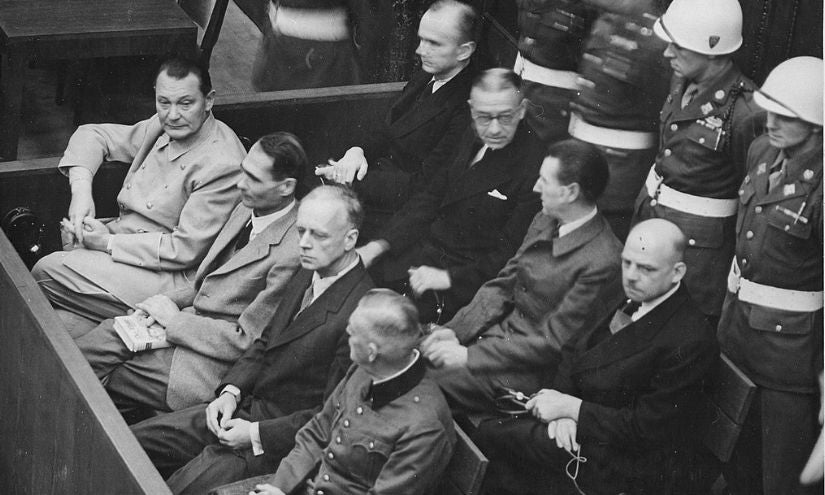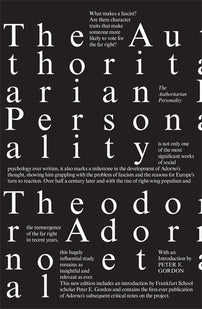Notes on Anti-Fascism and Psychology
Hannah Proctor on attempts to understand fascist thought through psychological analysis.

I think this is the right place to say something more about 'it'. Though of course there is no 'right' place or time, since there was no particular moment marking — then or now — 'its' beginning. And yet there did come a period when everyone was talking about 'it'; and we knew we had not been doing this until recently: there was a different ingredient in our lives…
'It', in short, is the word for helpless ignorance, or of helpless awareness…
'Have you heard anything new about it?'
'So and so said last that it…'
Worse still when the stage is reached of 'Have you heard anything new', when 'it' has absorbed everything into itself, and nothing else can be meant when people ask what is moving in our world, what moves our world. It. Only it, a much worse word than 'they'; for 'they' at least are humanity too, can be moved, are helpless, like ourselves.
'It', perhaps — on this occasion in history — was above all a consciousness of something ending.
— Doris Lessing, Memoirs of a Survivor
The entire problem of social psychology rests precisely upon the fact that it must be brought to bear on a form which is not only difficult to study but whose existence has not yet been the object of a precise definition.
— Georges Bataille, ‘The Psychological Structure of Fascism’
Those who find themselves living in times of crisis and disorientation often seek guidance in analogical thinking.
— Alberto Toscano, ‘Notes on Late Fascism’, 2017
In the wake of Brexit, in the wake of Trump, eyes still twitching from sleepless nights and days of online scrolling in darkened rooms when I wasn’t sitting around talking feverishly about ‘it’ I found myself reaching for books: studies or histories of studies of fascist mentality. The questions posed in the books I flicked through were similar even if the answers varied: why do people become fascists? Is it possible to stop people from becoming fascists? I read wildly, frantically, unsystematically. I could barely get through more than two pages at a time. I’d take random screenshots, tweet decontextualized fragments of text into the void or scrawl single words in my notebook.
Though I’d started reading these texts to help make sense of the present, I was more often struck by how untimely and inconclusive they seemed. They raised more questions than they answered. Although they suggested that fascism could be understood as a kind of pathology, defining it or pin-pointing its origins proved elusive. In the end, the notes I made became an attempt to describe that elusiveness rather than trying to evade it in order to produce some neat and clever-sounding theory. In doing so, answers remained evasive but new questions emerged.
1. SYMPTOMLESS AND UNDIAGNOSABLE
Notes on Rebecca Lemov, Database of Dreams: The Long Quest to Catalog Humanity
In a prison cell in Nuremberg in 1945 Hermann Göring, the second-highest ranking of the Nazis there on trial, expressed irritation at three small red spots on an inkblot shown to him by an American psychologist. It was speculated that Göring’s agitated emotional response to the colour red – considered alongside his long-standing morphine addiction and proclivity for wearing elaborate feathery costumes – could be taken to indicate a dangerously volatile and potentially pathological inner life. However, no conclusive diagnosis was given. Twenty-one Nazi detainees at Nuremberg were administered Rorschach tests, which joined records of tests conducted with 209 Danish Nazi collaborators. In the ensuing decades the tests continued to circulate and were interpreted and re-interpreted. A large number of dahlias, daffodils and roses were seen by Nazis in the inkblots, which some psychologists took to indicate an incapacity to relate to other people. But others who attempted to make sense of them contested this interpretation and maintained that there was nothing distinctive about the ‘Nazi protocols’ at all. In 1962 Hannah Arendt was scornful of an Israeli psychologist who, having administered the Rorshach to Adolf Eichmann prior to his trial in Jerusalem, declared that there was nothing psychologically unusual about the defendant. Evil, it seemed, was not just banal but symptomless and undiagnosable.
2. NO DEFINITIVE DIAGNOSIS WAS GIVEN
Notes on Daniel Pick, The Pursuit of the Nazi Mind: Hitler, Hess and the Analysts
Rudolf Hess, former Deputy Führer, who was among those who stood trial at Nuremberg, had already been examined by psychoanalysts and psychologists after being taken prisoner in Britain in 1941. Moving from a Scottish castle to the Tower of London to a country house in Surrey to a hospital in the Welsh town of Abergavenny, Hess was both prisoner and patient; his various interlocutors functioned as both intelligence gatherers and diagnosticians. His family history and childhood were examined. Problems with his gall-bladder were noted. Peculiar eating habits were observed (he ate no eggs, consumed no caffeine, had a preoccupation with being poisoned by Jews, and a conviction that the beans and peas he was served were as hard as stones). He was seen furtively wrapping up mysterious bundles of paper and hiding scraps of paper under pillows around his room. He was said to goose-step extravagantly when permitted to exercise which was interpreted as a performance of ‘super masculinity’, acting to mask his homosexual desire for Hitler. He once rescued some wasps from a honey jar and spread out their wings to dry in the sun, which was taken to indicate his identification with their situation – poor little wasps. He would answer questions about the treatment of Jews in Germany by claiming that Jews had hypnotized gentile Germans forcing them to act inhumanely. He was obsessed with Jewish ‘magnetism’. Again and again he repeated that if the Nazis had committed violent acts, then the Jews were to blame (sometimes adding that Britain had invented concentration camps anyway). He did not react upon hearing his son’s or wife’s name and claimed his memories were shrouded in mist. He said the air smelled of corpses.
It was assumed that analyzing Hess could provide insights into the appeal of Nazism and into the so-called ‘Nazi mind’ more generally, but ultimately no definitive diagnosis was given: ‘He was conceputalized variously, or in combination, as obsessional, hysterical, paranoid, schizoid; a malingerer, manipulator, and fantasist; highly neurotic; dissociated and confused; perverse and phobic.’
3. PERSISTENT PERPLEXITY
Notes on Wilhelm Reich, The Mass Psychology of Fascism
Wilhelm Reich’s Mass Psychology of Fascism (first published in 1933, shortly after Hitler came to power, and revised in 1942) was less concerned with the psychologies of Nazi leaders, than with the German masses. For Reich it was impossible to explain the phenomenon of people voting against their class interests with recourse to economic arguments alone; the answer, he insisted, was libidinal. Fascism, he claimed, had an irrational, excessive appeal that lay in the depths of the unconscious with a long – perhaps even primal – history. Reich linked fascism’s appeal to sexual repression, the origins of which he located in traditional patriarchal family structures. Reactionaries are produced and reproduced within the ‘authoritarian family’ in which women serve as ‘nothing but child-bearing machines’. But as Dagmar Herzog notes, Reich couldn’t quite make up his mind about whether people were attracted to the content of fascist ideology or merely to the emotive form in which it was communicated. The Mass Psychology of Fascism exhibits, she writes, a ‘persistent perplexity over the paths by which ideologies entered psyches, and the apparent undecideability surrounding whether the content of fascist ideas was ‘hogwash,’ irrelevant in comparison with its emotional effect, or whether in fact that hogwash should be scrutinized for clues to its hidden meanings.’
4. THE AUTHORS REMAIN UNCLEAR
Notes on Theodor Adorno et al., The Authoritarian Personality
Based on research conducted immediately after the Second World War, The Authoritarian Personality (1950) was concerned with identifying the potentially fascistic individual, which the social scientists involved in the project posited could be diagnosed by identifying underlying personality structures. These experiments were not conducted with avowed fascists but sought to ascertain so-called ordinary Americans’ susceptibility to fascism. Questionnaires designed to provide an insight into people’s hidden feelings and dispositions were distributed to predominantly white people from different social groups and organizations mostly based in the San Francisco Bay Area – students, professionals, prison inmates, army veterans, longshoremen, labor union members, church congregations etc. Three hour long clinical interviews were conducted with a smaller sample of these individuals who were paid $3 to participate.
The researchers contended that anti-Semitism was part of a broad ‘ideological framework’. In addition to questions about anti-Semitism the tests also attempted to investigate anti-Black and anti-Japanese racism, levels of patriotism, views on gender, sexual proclivities, religious attitudes, economic opinions and feelings towards Communists. It was noted that ‘the ethno-centric “need for an outgroup” prevents... identification with humanity as a whole’. The researchers found that anti-Semitism operated in a similar manner to hostility towards other groups and was usually combined with a conviction that the ‘ingroup’ the individual belonged to was superior to all others: ‘the ingroup is regarded as the opposite of the outgroup: clean, unaggressive, hard-working and ambitious, honest, disciplined, well-mannered.’
As in Reich’s analysis, a major emphasis was placed on childhood experience and family relationships: Were the parents strict? Were they cruel? Was there a moment of rebellion against the father? Was there a loving attachment to the mother? Were there pronounced sibling rivalries? etc. People whose parents demanded less obedience were found to be least susceptible to fascism.
The researchers suggested that countermeasures could focus on ‘stereotypy, emotional coldness, identification with power, and general destructiveness,’ arguing that focusing solely on eliminating discrimination against a particular group would not resolve the underlying psychological problems but would merely see hostility and violence redirected towards other groups. Nonetheless a chapter by Theodor Adorno remarks that it remains ‘an open question whether and to what extent the fascist danger really can be fought with psychological weapons.’ The authors remain unclear what would turn a potential fascist into a fascist; unsure what would drive a prejudiced person to act on their prejudice. They also remain pessimistic about the efficacy of individual psychotherapy being used in cases of adults with authoritarian personalities. Ultimately, they note that fascists are ‘products of the total organization of society and are to be changed only when that society is changed. It is not for the psychologist to say how such changes are to be brought about.’
***
Almost all of these examples are psychoanalytic or influenced by psychoanalysis. And many more examples could be added to the list. But none of the things I haphazardly read really helped to make sense of the present. The studies were inconclusive, the methodologies anachronistic, the political and economic contexts they addressed different. It was hard to find meaning in all the tiny details – daffodils and wasps. Many of these studies argued that fascism had its origins in childhood. A lot were particularly obsessed with fathers. But even if these arguments seem convincing, locating fascist tendencies in infancy makes it difficult to know how fascism in adults could ever be counteracted, because as Klaus Theweleit says (in another attempt to examine proto-fascist mentality, Male Fantasies) ‘it is too late to peer into the cradles of the children who would later become soldier males’. It is always too late to retroactively change adults’ experiences of being children.
Perhaps as the authors of The Authoritarian Personality concluded psychology is the wrong starting point for bringing about a transformation in the total organization of society but the problem seems to operate according to an inescapably circular logic: it’s impossible to take psychology out of the equation altogether as society will never be totally transformed if people do not (psychologically) desire its transformation.
In arranging these fragments, I keep thinking of a comment made in passing at the beginning of The Authoritarian Personality. The authors state that they did not study the potential anti-fascist personality because they did not believe any pattern of thought distinguished anti-fascist individuals. But why not? What would a psychology of anti-fascism require, and how might it be useful in such times?
Hannah Proctor is a Wellcome Trust Research Fellow at the Centre for the Social History of Health and Healthcare at the University of Strathclyde, Glasgow.
[book-strip index="1" style="buy"] [book-strip index="2" style="buy"]
